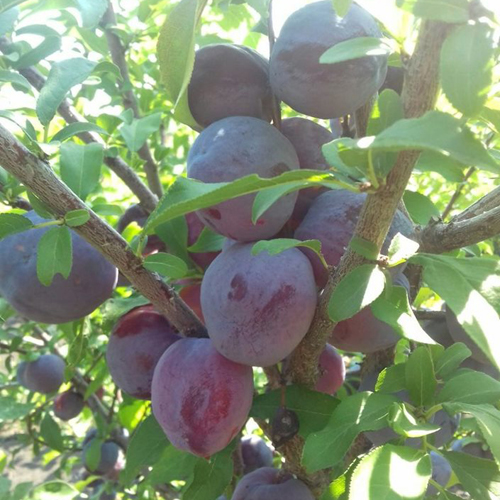Cherry plum variety Cleopatra
The hybridization of cherry plum and Chinese plum, carried out in Russia in the middle of the twentieth century, led to the emergence of a fundamentally new stone fruit culture - Russian plum. New hybrids combine high productivity of cherry plum and excellent taste of plum. Cleopatra became one of the worthy representatives of this group. Its authors: A.V. Isachkin, N.V. Agafonov and B.N. Vorobiev. The new variety was obtained by free pollination Kuban comet... Since 1997, the variety has been under variety testing, and in 2004 it was entered into the State Register of Breeding Achievements of Russia in the Central Region (Moscow, Tula, Bryansk, Ivanovskaya, Kaluga, Ryazan, Smolensk and Vladimir regions).
Description
The tree is small in size, about 3.0 - 3.5 meters high, but not higher than 4.0. The crown is not thickened, spreading, broadly conical in shape. Shoots are upright, thin, brown bark. The leaves are green, elliptical, gradually tapering towards the apex, the base is wedge-shaped, the edge is large-serrate. The surface of the leaf blade is smooth, with a slight gloss, curved in an arc along the central vein. The petiole is uncolored, of medium size.

Fruits are one-dimensional, round-oval in shape, rather large - weighing 37 grams. The funnel is narrow, of medium depth, the top is flat. The lateral suture is shallow, but well-defined, noticeable. The skin is dense, not too thick, during ripeness it becomes dark red-violet, the waxy coating is strongly pronounced. The stalk is average in all respects. The flesh of the cherry plum is dense and gristly, red in color. The taste is very good, it harmoniously combines sweetness and sourness. Tasters' assessment of 4.7 points on a five-point system. The stone is not very large, half is separated from the pulp. The fruits contain: dry matter 9.3%, sugar 5.5%, acid 3.1%.
Characteristics
- The beauty of Cleopatra has a rather high fertility rate. Already 4 years after planting, you can feast on delicious fruits;
- and if everything is clear with the previous characteristic, then there is some confusion with the ripening period. Numerous sources classify the variety as early, sometimes as middle or generally as late. This disagreement can only be explained by the growing conditions and climate. What does the State Register tell us about this: it classifies our heroine as a mid-season variety;
- the fruits do not ripen at the same time, so you can harvest within 2 weeks;
- official sources do not provide accurate data on the yield. But, according to reviews, the cherry plum is medium-yielding - from 20 to maximum 40 kg per tree, but at the same time, which is important, the variety is distinguished by stable fruiting;
- our heroine belongs to the self-infertile, which forces us to plant at least a couple of suitable varieties in the garden that bloom at the same time as her;
- The winter hardiness of the variety is very good, it is not without reason that it is recommended for growing in a region where fluctuations in winter temperatures are frequent. In addition, Cleopatra's flower buds are also resistant to early spring frosts, if damage is noted, then it is insignificant;
- drought resistance is also good, above the average, which makes it possible to cultivate the variety even in hot regions where there is an acute lack of moisture;
- immunity is not high enough. VNIISPK describes the relative resistance of cherry plum to major diseases;
- transportability is good. Subject to the appropriate storage standards, the keeping quality of the crop will be a month or even more;
- the way of using is universal. The fruits are consumed in their natural form. They are also suitable for processing into jam, preserves, compote.
Agrotechnics
You can plant seedlings in the garden in spring or autumn. Our heroine loves the sun, so choose a sunny area for her, preferably in the southern part of the garden. Agrotechnology does not differ from the basic rules for caring for the crop as a whole. But, given the not too high immunity of the plant, it will be necessary to inspect the tree and carry out preventive spraying regularly.
Cleopatra deserves to be noticed. The representative of new hybrids shows good early maturity, bears fruit stably, is not afraid of frost and temperature extremes. She is not picky about leaving. Its main advantage, perhaps, is its taste, thanks to which the fruits are often used in their natural form as a dessert. The disadvantages include insufficient disease resistance and self-infertility. But in the first case, the situation will be corrected by preventive treatment of trees, and it will be possible to increase the productivity and quality of fruits with the help of a pollinator, besides, another variety of cherry plum in the garden will allow you to compare the taste characteristics of both varieties.








